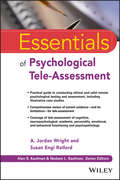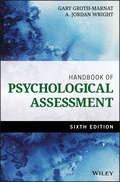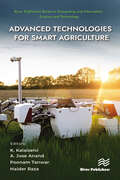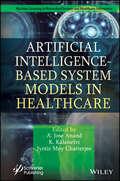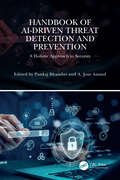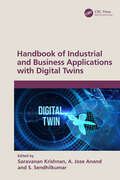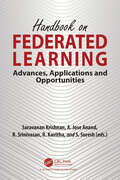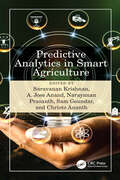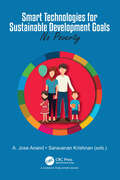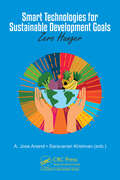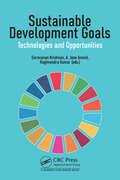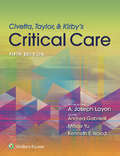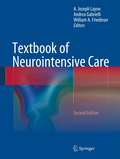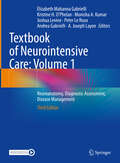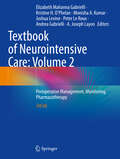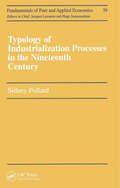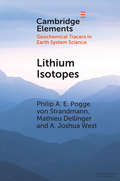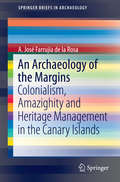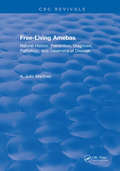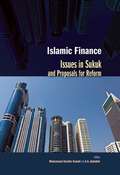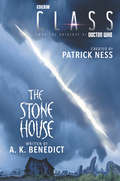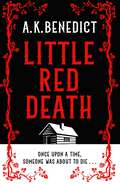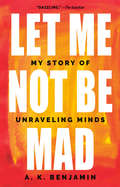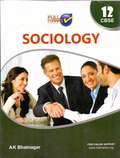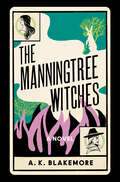- Table View
- List View
Essentials of Psychological Tele-Assessment (Essentials of Psychological Assessment)
by A. Jordan Wright Susan Engi RaifordDiscover a comprehensive and practical guide to the use of tele-assessments in psychological testing from two leading voices in psychology. Essentials of Psychological Tele-Assessment delivers a primer on the current state of professional knowledge related to psychological tele-assessment, ranging from the ethical and empirical considerations to the practical applications of tele-assessment procedures. The overarching framework encourages the balancing of the limitations of the current state of the research literature with the very real needs for assessment services to continue, even when in-person procedures are not feasible. This book includes discussion on a broad range of tests and measures, with information related to both the state of the empirical support for tele-tests and measures, with information related to both the state of the empirical support for tele-assessment utilizing them and the practical 'how-to' for administering, scoring and interpreting daa that emerge from them. Additionally, frameworks for integrating the data that emerge from tele-assessment procedures are discussed. The book is applicable to those transitioning to tele-assessment practice and those training in a wide variety of training programs. Readers will also benefit from the inclusion of: - Practical checklists and information about specific tests must be adapted to the realities of the tele-health environment. - Information about how the resutls of tests should be interpreted differently to account for the tele-health environment. -Case examples and studies to illustrate many of the challenges of working in tele-assessment -Guidance on how to balance the limitations of the state of the empirical literature on the validity of tele-assessment with the real-world needs of clients. Perfect for psychologists and trainees in a variety of health services, including clinical, counseling, school and forensic psychology, Essentials of Psychological Tele-Assessment will also earn a place in the libraries of anyone utilizing or training in cognitive, developmental, neuropsychological, psychoanalytic, psychodynamic, and interpersonal models of psychological assessment.
Handbook of Psychological Assessment
by Gary Groth-Marnat A. Jordan WrightOrganized according to the sequence mental health professionals follow when conducting an assessment, this classic resource covers principles of assessment, evaluation, referral, treatment planning, and report writing. Written in a practical, skills-based manner, the sixth editionprovides guidance on the most efficient methods for selecting and administering tests, interpreting assessment data, how to integrate test scores and develop treatment plans as well as instruction on ways to write effective, client-oriented psychological reports. The latest edition provides through coverage of the most commonly used assessment instruments including the Wechsler Intelligence Scales, Wechsler Memory Scales, Minnesota Multiphasic Personality Inventory, Personality Assessment Inventory, Millon Clinical Multiaxial Inventory, NEO Personality Inventory, Rorschach, Thematic Apperception Test, and brief assessment instruments for treatment planning, monitoring, and outcome assessment. In addition, this sixth edition includes: Fully updated with new research and the DSM-5 and ICD-10 New chapter on the NEO Personality Inventory-3. The NEO inventories provide a comprehensive assessment of adult and adolescent personality based on the strongly empirically supported Five Factor Model of personality. New chapter on the Personality Assessment Inventory (PAI), which has gained both strong empirical support and wide clinical popularity. Includes updated information on the newly developed Wechsler Intelligence Scale for Children, Fifth Edition (WISC-V). The chapter on the Minnesota Multiphasic Personality Inventory includes coverage of both the MMPI-2 and the MMPI-2-Restructured Form (MMPI-2-RF) The chapter on the Rorschach discusses both the Comprehensive System and the Rorschach Performance Assessment System (R-PAS). The "Use with Diverse Groups" sections reflect the more extensive use of assessment for a wide variety of populations and the importance of competently and sensitively working with diverse populations. Greater emphasis on making assessment more user friendly and consumer oriented. This is reflected in suggestions for using everyday language in reports, connecting interpretations to actual client behavior, strategies for wording interpretations in a manner likely to enhance client growth, and the importance of collaborating with clients. The treatment planning and clinical decision making chapter has been completely updated, and the psychological report writing chapter has been updated to include the American Psychological Association and Society for Personality Assessment's current thinking about proficiency in personality assessment.
Advanced Technologies for Smart Agriculture (River Publishers Series in Computing and Information Science and Technology)
by Poonam Tanwar K. Kalaiselvi A. Jose Anand Haider RazaThis book brings new smart farming methodologies to the forefront, sparked by pervasive applications with automated farming technology. New indigenous expertise on smart agricultural technologies is presented along with conceptual prototypes showing how the Internet of Things, cloud computing, machine learning, deep learning, precision farming, crop management systems, etc., will be used in large-scale production in the future. The necessity of available welfare systems for farmers’ well-being is also discussed in the book. It draws the conclusion that there is a greater need and demand today for smart farming methodologies driven by technology than ever before.
Artificial Intelligence-Based System Models in Healthcare
by K. Kalaiselvi A. Jose Anand Jyotir Moy ChatterjeArtificial Intelligence-Based System Models in Healthcare provides a comprehensive and insightful guide to the transformative applications of AI in the healthcare system. This book is a groundbreaking exploration of the synergies between artificial intelligence and healthcare innovation. In an era where technological advancements are reshaping the landscape of medical practices, this book provides a comprehensive and insightful guide to the transformative applications of AI in healthcare systems. From conceptual foundations to practical implementations, the book serves as a roadmap for understanding the intricate relationships between AI-based system models and the evolution of healthcare delivery. The first section delves into the fundamental role of technology in reshaping the healthcare landscape. With a focus on daily life activities, decision support systems, vision-based management, and semantic frameworks, this section lays the groundwork for understanding the pivotal role of AI in revolutionizing traditional healthcare approaches. Each chapter offers a unique perspective, emphasizing the intricate integration of technology into healthcare ecosystems. The second section takes a deep dive into specific applications of AI, ranging from predictive analysis and machine learning to deep learning, image analysis, and biomedical text processing. With a focus on decision-making support systems, this section aims to demystify the complex world of AI algorithms in healthcare, offering valuable insights into their practical implications and potential impact on patient outcomes. The final section addresses the modernization of healthcare practices and envisions the future landscape of AI applications. From medical imaging and diagnostics to predicting ventilation needs in intensive care units, modernizing health record maintenance, natural language processing, chatbots for medical inquiries, secured health insurance management, and glimpses into the future, the book concludes by exploring the frontiers of AI-driven healthcare innovations. Audience This book is intended for researchers and postgraduate students in artificial intelligence and the biomedical and healthcare sectors. Medical administrators, policymakers and regulatory specialists will also have an interest.
Handbook of AI-Driven Threat Detection and Prevention: A Holistic Approach to Security
by Pankaj Bhambri A. Jose AnandIn today’s digital age, the risks to data and infrastructure have increased in both range and complexity. As a result, companies need to adopt cutting-edge artificial intelligence (AI) solutions to effectively detect and counter potential threats. This handbook fills the existing knowledge gap by bringing together a team of experts to discuss the latest advancements in security systems powered by AI. The handbook offers valuable insights on proactive strategies, threat mitigation techniques, and comprehensive tactics for safeguarding sensitive data.Handbook of AI-Driven Threat Detection and Prevention: A Holistic Approach to Security explores AI-driven threat detection and prevention, and covers a wide array of topics such as machine learning algorithms, deep learning, natural language processing, and so on. The holistic view offers a deep understanding of the subject matter as it brings together insights and contributions from experts from around the world and various disciplines including computer science, cybersecurity, data science, and ethics. This comprehensive resource provides a well-rounded perspective on the topic and includes real-world applications of AI in threat detection and prevention emphasized through case studies and practical examples that showcase how AI technologies are currently being utilized to enhance security measures. Ethical considerations in AI-driven security are highlighted, addressing important questions related to privacy, bias, and the responsible use of AI in a security context. The investigation of emerging trends and future possibilities in AI-driven security offers insights into the potential impact of technologies like quantum computing and blockchain on threat detection and prevention.This handbook serves as a valuable resource for security professionals, researchers, policymakers, and individuals interested in understanding the intersection of AI and security. It equips readers with the knowledge and expertise to navigate the complex world of AI-driven threat detection and prevention. This is accomplished by synthesizing current research, insights, and real-world experiences.
Handbook of Industrial and Business Applications with Digital Twins
by Saravanan Krishnan A. Jose Anand S. SendhilkumarA digital twin represents the indistinguishable digital counterpart of the physical object to simulate, monitor and test with real time synchronization. This book presents the framework and important key aspects of digital twins, including various technologies with coverage of the digital twins in various industry and business applications. It provides a background of modeling and simulation, computer sensor technology and other areas required creating the next wave of digital twins.Features: Presents exclusive material on industrial and business applications of digital twins Includes diversified digital twin applications with use cases Focuses on tools and methods for digital twins, platforms, application domains and industries Emphasizes advances and cutting-edge technologies throughout Reviews artificial intelligence (AI), fog/edge computing, industrial automation, blockchains and the Internet of Things (IoT) This book is aimed at researchers and graduate students in cloud computing, simulation, the IoT and computer engineering.
Handbook on Federated Learning: Advances, Applications and Opportunities
by S. Suresh R. Srinivasan Saravanan Krishnan A. Jose Anand R. KavithaMobile, wearable, and self-driving telephones are just a few examples of modern distributed networks that generate enormous amount of information every day. Due to the growing computing capacity of these devices as well as concerns over the transfer of private information, it has become important to process the part of the data locally by moving the learning methods and computing to the border of devices. Federated learning has developed as a model of education in these situations. Federated learning (FL) is an expert form of decentralized machine learning (ML). It is essential in areas like privacy, large-scale machine education and distribution. It is also based on the current stage of ICT and new hardware technology and is the next generation of artificial intelligence (AI). In FL, central ML model is built with all the data available in a centralised environment in the traditional machine learning. It works without problems when the predictions can be served by a central server. Users require fast responses in mobile computing, but the model processing happens at the sight of the server, thus taking too long. The model can be placed in the end-user device, but continuous learning is a challenge to overcome, as models are programmed in a complete dataset and the end-user device lacks access to the entire data package. Another challenge with traditional machine learning is that user data is aggregated at a central location where it violates local privacy policies laws and make the data more vulnerable to data violation. This book provides a comprehensive approach in federated learning for various aspects.
Predictive Analytics in Smart Agriculture
by Saravanan Krishnan Sam Goundar Narayanan Prasanth Christo Ananth A. Jose AnandPredictive Analysis in Smart Agricultureexplores computational engineering techniques and applications in agriculture development. Recent technologies such as cloud computing, IoT, big data, and machine learning are focused on for smart agricultural engineering. The book also provides a case-oriented approach for IoT-based agricultural systems.This book deals with all aspects of smart agriculture with state-of-the-art predictive analysis in the complete 360-degree view spectrum. The book includes the concepts of urban and vertical farming using Agro IoT systems and renewable energy sources for modern agriculture trends. It discusses the real-world challenges, complexities in Agro IoT, and advantages of incorporating smart technology. It also presents the rapid advancement of the technologies in the existing Agri model by applying the various techniques. Novel architectural solutions in smart agricultural engineering are the core aspects of this book. Several predictive analysis tools and smart agriculture are also incorporated.This book can be used as a textbook for students in predictive analysis, agriculture engineering, precision farming, and smart agriculture. It can also be a reference book for practicing professionals in cloud computing, IoT, big data, machine learning, and deep learning working on smart agriculture applications.
Smart Technologies for Sustainable Development Goals: No Poverty
by Saravanan Krishnan A. Jose AnandSustainable Development Goals or SDGs refer to the UN stipulated road-map for development in 17 defined areas, by 2030. It was built on the previously established Millennium Development Goals (MDG). This first volume (SDG-1) deals with eradicating poverty with the help of modern ICT technologies needed to end poverty and create a better society. This much needed book, which is the first of its type to offer a specific focus on the relationship between technology and the SDG-1 goal, will be valuable for all working in the subject of global sustainable development. Global organisations and representatives of governments targeting no poverty share knowledge on these ICT practices to eradicate poverty in all means.
Smart Technologies for Sustainable Development Goals: Zero Hunger
by Saravanan Krishnan A. Jose AnandSustainable Development Goals (SDGs) give the UN a road-map for development, with Agenda 2030 as the target. It was built on the previously established Millennium Development Goals (MDGs). This book examines the supporting technologies needed to achieve SDG 2: reducing hunger and creating a better society. This much-needed book, the first of its type to offer a specific focus on the relationship between technology and SDG 2, will be valuable for academics working in the subject of global sustainable development. This book will also be useful for international organisations and representatives, who will be able to share knowledge on technological views to minimise hunger rates.
Sustainable Development Goals: Technologies and Opportunities
by Raghvendra Kumar Saravanan Krishnan A. Jose AnandSustainable Development Goals (SDGs) are goals set by the United Nations to address the global challenges and foster sustainable development and harmony. To effectively achieve these goals, leveraging advanced technologies and engineering techniques is paramount. This edited volume explores the pivotal role of technology and engineering in advancing the SDGs across various sectors such as green energy, water management, healthcare, agriculture, and smart manufacturing. From innovative solutions in clean energy production to precision agriculture and smart cities, technological advancements offer scalable and efficient approaches to tackle complex sustainability issues.
Civetta, Taylor, & Kirby's Critical Care Medicine
by A. Joseph Layon Andrea Gabrielli Mihae Yu Kenneth E. WoodCovering every problem encountered in today’s intensive care unit, this leading critical care textbook presents the knowledge and expertise of more than 350 global experts in this fast-changing field. Beginning with the social aspects of medicine, it then discusses monitoring and organ system pathobiology followed by specific diseases states/syndromes. Each chapter begins with immediate concerns and proceeds to broader-based discussions of relevant pathophysiologic and clinical issues.
Textbook of Neurointensive Care
by William A. Friedman A. Joseph Layon Andrea GabrielliThis updated and refined new edition is the only book to provide a comprehensive approach to the intensive care of neurologically injured patients from the emergency room and ICU through the operating room and post-surgical period. It reviews neuroanatomy, neuroradiology, and neurophysiology, examines the neurological problems most frequently seen in intensive care, and describes the various types of neurosurgery. General issues are discussed, such as cardiac care, fluids and electrolytes, nutrition, and monitoring as well as more specific conditions and complications including elevated intracranial pressure, seizures, and altered mental states.
Textbook of Neurointensive Care: Neuroanatomy, Diagnostic Assessment, Disease Management
by Joshua Levine A. Joseph Layon Andrea Gabrielli Elizabeth Mahanna Gabrielli Kristine H. O’Phelan Monisha A. Kumar Peter Le RouxThis extensively updated edition provides a comprehensive review of intensive care for neurologically injured patients from the emergency room and ICU through the operating room and post-surgical period in two comprehensive volumes. The Editors of this first volume present a comprehensive textbook that incorporates best practice/evidence-based medicine and performance improvement, while it champions the three characteristics needed in our neuro–ICUs: patient and family centered high-quality care, education, and discovery. This volume concentrates on neuroanatomy, diagnostic assessment and disease management, examining the neurological problems most frequently seen in intensive care, and describes the various types of neurosurgery and critical features of the management of patients. General issues are discussed across the textbook, such as cardiac care, fluids and electrolytes, nutrition, and monitoring as well as more specific conditions and complications including elevated intracranial pressure, seizures, and altered mental states. Listening to an injured brain is not easy. It takes knowledge, dedication, and understanding of the critically ill patient and their family. Textbook of Neurointensive Care Volume 1: Neuroanatomy, Diagnostic Assessment, Disease Management provides the reader with a detailed resource for studying this most complex area of medicine. It is thus essential reading for all trainees and professionals in critical care, neurosurgery, anesthesia and neurology.
Textbook of Neurointensive Care: Perioperative Management, Monitoring, Pharmacotherapy
by Joshua Levine A. Joseph Layon Andrea Gabrielli Elizabeth Mahanna Gabrielli Kristine H. O’Phelan Monisha A. Kumar Peter Le RouxThis extensively updated edition provides a comprehensive review of intensive care for neurologically injured patients from the emergency room and ICU through the operating room and post-surgical period in two comprehensive volumes. The Editors of this second volume present a comprehensive textbook that incorporates best practice/evidence-based medicine and performance improvement, while it champions the three characteristics needed in our neuro–ICUs: patient and family centered high-quality care, education, and discovery. This volume concentrates on perioperative management, monitoring and pharmacotherapy, examining the neurological problems most frequently seen in intensive care, and describes the various types of neurosurgery and critical features of the management of patients. General issues are discussed across the textbook, such as cardiac care, fluids and electrolytes, nutrition, and monitoring as well as more specific conditions and complications including elevated intracranial pressure, seizures, and altered mental states. Listening to an injured brain is not easy. It takes knowledge, dedication, and understanding of the critically ill patient and their family. Textbook of Neurointensive Care Volume 2: Perioperative Management, Monitoring, Pharmacotherapy provides the reader with a detailed resource for studying this most complex area of medicine. It is thus essential reading for all trainees and professionals in critical care, neurosurgery, anesthesia and neurology.
Typology of Industrialization Processes in the Nineteenth Century
by A. Joseph PollardThe industrial revolution in Great Britain was the first example of the transition to a modern industrial economy. Certain features of this transition were later copied and modified by other coutries undergoing the same process. This book considers the main similarities and differences in the process of industrialization, grouping the main countries
Lithium Isotopes: A Tracer of Past and Present Silicate Weathering (Elements in Geochemical Tracers in Earth System Science)
by Philip A. Strandmann Mathieu Dellinger A. Joshua WestLithium isotopes are a relatively novel tracer of present and past silicate weathering processes. Given that silicate weathering is the primary long-term method by which CO2 is removed from the atmosphere, Li isotope research is going through an exciting phase. We show the weathering processes that fractionate dissolved and sedimentary Li isotope ratios, focusing on weathering intensity and clay formation. We then discuss the carbonate and silicate archive potential of past seawater δ7Li. These archives have been used to examine Li isotope changes across both short and long timescales. The former can demonstrate the rates at which the climate is stabilised from perturbations via weathering, a fundamental piece of the puzzle of the long-term carbon cycle.
An Archaeology of the Margins: Colonialism, Amazighity and Heritage Management in the Canary Islands (SpringerBriefs in Archaeology)
by A. José Farrujia de la RosaThis book analyses the problematics of archaeological heritage management in the Canary Islands, which are echoed in other parts of the world where the indigenous heritage is under-represented. The present-day management of Canarian archaeological heritage has a very specific and unusual context given that the archipelago is located on the fringes of Europe, belonging to Spain and therefore to the European Unión, but geographically and in terms of early history being part of Africa. From a theoretical perspective, then, the proposed book analyzes issues such as the effects of colonialism and eurocentrism on the management of the archaeological heritage. It also examines the evolutionist and historico-cultural models used to analyze past societies and, ultimately, used to create identities that influence archaeological heritage management itself. From a practical point of view, the book presents a proposal for enhancing the archaeological heritage of the Canary Islands through the creation of archaeological parks (providing some concrete examples in the case of the city of La Laguna) and the active involvement of the local community. Parallel to this, the book considers the Canarian Archipelago as part of a problematic that is not unique to this area but is an example of poor indigenous heritage management overall. It demonstrates how the course of history and the politics of the past still have an excessive influence on the way in which the present-day archaeological heritage is interpreted and managed. Therefore, this book provides an almost unique opportunity for uncovering the history of archaeology within the margins of Europe (in fact, in an African region) and exploring colonial and foreign influences. In many ways it is a mirror of archaeological mainstreams and an exercise in (re)thinking the aim and status of present-day archaeology.
Free-Living Amebas: Natural History, Prevention, Diagnosis, Pathology, and Treatment of Disease
by A. Julio MartinezThis book places greater emphasis on the practical problems of epidemiology, prevention, diagnosis, and pathological aspects of the two principle types of free-living amoebic infection: the acute disease produced by Naegleria fowleri and the chronic, subacute and opportunistic form, produced by acanthamoeba spp.
Islamic Finance: Issues in Sukuk and Proposals for Reform
by Mohammad Hashim Kamali A. K. AbdullahThis collection of essays brings together leading scholars and practitioners to discuss contemporary issues in the rapidly expanding sukuk market, and frankly debates the challenges facing it since the 2008 financial crisis.Highly recommended for practitioners, scholars, and students of Islamic finance.Professor Mohammad Hashim Kamali is the founding chairman and CEO of the International Institute of Advanced Islamic Studies (IAIS) in Malaysia, and is a leading authority in Islamic jurisprudence, Islamic finance, and human rights in Islamic law.A.K. Abdullah is an assistant research fellow at the IAIS.
Class: The Stone House (Class #1)
by Patrick Ness A. K. BenedictOne of three thrilling companion novels, set in the universe of the new Doctor Who spin-off show, Class, created by #1 New York Times bestselling novelist Patrick Ness, author of The Rest of Us Just Live Here and the Carnegie Medal-winning A Monster Calls. Don't go near the house, whatever you do. It wants the lonely, the lost, the vulnerable. It wants you. Tanya keeps having bad dreams about the old stone house around the corner from Coal Hill School—and a girl trapped there, screaming and terrified. When Tanya and her friends go to investigate the strange house covered in cobwebs, they stumble onto their own worst nightmares come to life. But there is a presence haunting the house that is even more powerful than their individual horrors. A presence that may not want to let them go... In spite of the danger, Tanya is determined to free the mysterious girl in the house. But they are running out of time—the house is scheduled for demolition. With the help of their teacher Miss Quill, Tanya and three other kids prepare to fight their nightmares, and whatever other monsters they hear scuttling around in the walls. But how can they fight against monsters that are supposed to exist only in their dreams?
Little Red Death: A mind-bending murder mystery like nothing you've read before - enter the woods, if you dare . . .
by A. K. BenedictONCE UPON A TIME LIKE YOU'VE NEVER READ IT BEFORE . . . DI Lyla Rondell is on the case of a lifetime. Tasked with investigating a series of perplexing deaths, the only lead she has is that each appears to be based on a different classic fairy tale. Far from the stuff of bedtime stories, the press is having a field day with what they have named the Grimm Ripper Murders. But as the bodies stack up, Lyla&’s whole world is about to flip on its head. Because the killer&’s bloody trail stretches deep into her own origin story, and when she discovers the truth, nothing will ever be the same again. Faced with the fact that everything she knows is fiction, Lyla will have to take a little creative license of her own if she&’s going to turn the final page on the killings . . .
Let Me Not Be Mad: My Story of Unraveling Minds
by A. K. BenjaminInspired by Dr. A. K. Benjamin's years working as a clinical neuropsychologist at a London hospital, this multilayered narrative interweaves Benjamin's own sometimes shocking personal experiences with those of his mentally disordered patients.What do doctors actually think about when you list your problems in the consulting room? Are they really listening to you? Is the connection all in your head? Every day for ten years--even while his hospital became the set for a reality television series--clinical neuropsychologist A. K. Benjamin confronted these questions, and this book is his attempt to tell the truth about what happens in these rooms in hospitals the world over.What begins as a series of exquisitely observed case studies examining personalities on the brink of collapse soon morphs into a unique work of nonfiction as Benjamin's own psyche begins to twist the story in surprising ways. Blazingly original, Let Me Not Be Mad undermines the authority we so willingly hand over to clinical psychologists as it bears witness to the self-obsession of Western society, and ultimately offers a glimpse of what it might mean to be sane and truly empathetic.Fractured, sad, playful, brilliant, and confrontational, this is a confession by a professional that delves into the heart of the patient-doctor relationship and ultimately finds love. This twisting psychological journey will be read and reread.
Sociology class 12- NCERT Guide Book
by A. K. BhatnagarSociology Class -XII - NCERT GUIDE BOOK has been developed as per the latest syllabus issued by CBSE. It provides complete support material for the NCERT textbooks - Part A: Indian Society and Part B: Social Change and Development in India. The content of the book includes Facts that Matter, Words that Matter along with the complete solutions of NCERT Textbook Questions and also a lot of additional questions set on the pattern of board examination. Hence it is a complete tutorial support for the students. The strength of the series lies in the process that we put in place while creating this support book: (a) Identifying the learning difficulties experienced by a large number of students struggling to perform satisfactorily in the examinations. (b) Commissioning experienced writers who have been involved in teaching students who need support. (c) Discussing and deciding on the ideal structure to present each concept in the course in a manner that can be easily understood by students. (d) Focusing on presenting each concept in learner-friendly chunks so that the students improve their skills step-by-step. (e) Trials with students who are self-reliant learners because of non-availability of support in their home environment. (f) Restructuring units on the basis of the trial results.
The Manningtree Witches
by A. K. BlakemoreWolf Hall meets The Favourite in this beguiling debut novel that brilliantly brings to life the residents of a small English town in the grip of the seventeenth-century witch trials and the young woman tasked with saving them all from themselves.England, 1643. Puritanical fervor has gripped the nation. And in Manningtree, a town depleted of men since the wars began, the hot terror of damnation burns in the hearts of women left to their own devices.Rebecca West, fatherless and husbandless, chafes against the drudgery of her days, livened only occasionally by her infatuation with the handsome young clerk John Edes. But then a newcomer, who identifies himself as the Witchfinder General, arrives. A mysterious, pious figure dressed from head to toe in black, Matthew Hopkins takes over the Thorn Inn and begins to ask questions about what the women on the margins of this diminished community are up to. Dangerous rumors of covens, pacts, and bodily wants have begun to hang over women like Rebecca—and the future is as frightening as it is thrilling.Brimming with contemporary energy and resonance, The Manningtree Witches plunges its readers into the fever and menace of the English witch trials, where suspicion, mistrust, and betrayal run amok as a nation's arrogant male institutions start to realize that the very people they've suppressed for so long may be about to rise up and claim their freedom.
